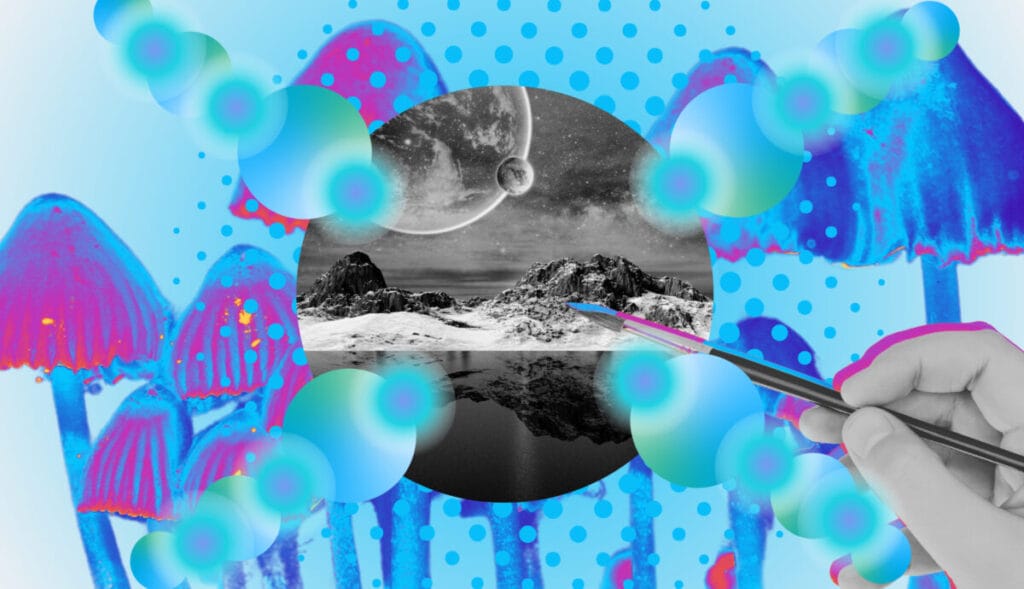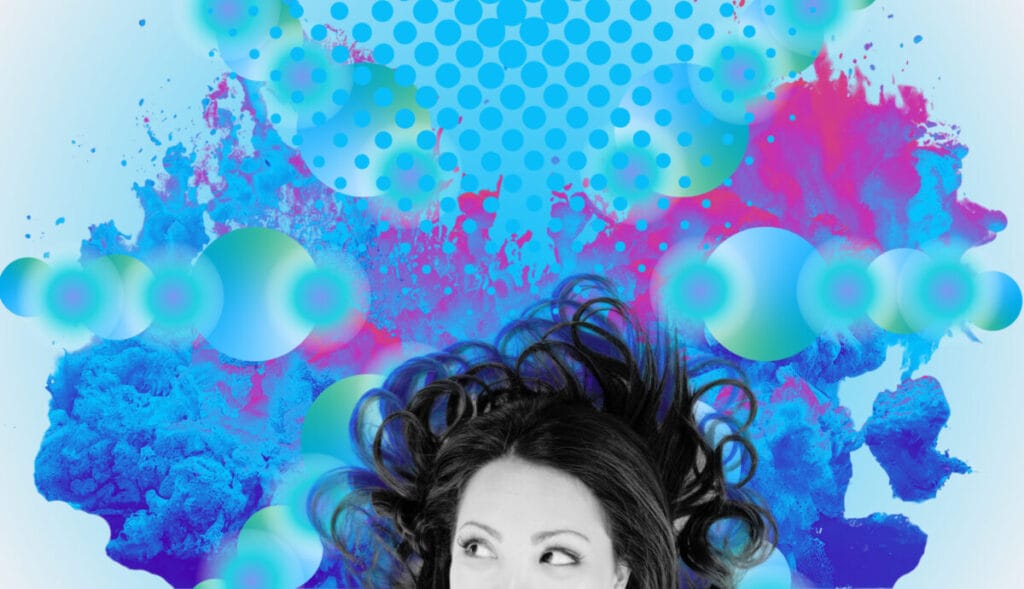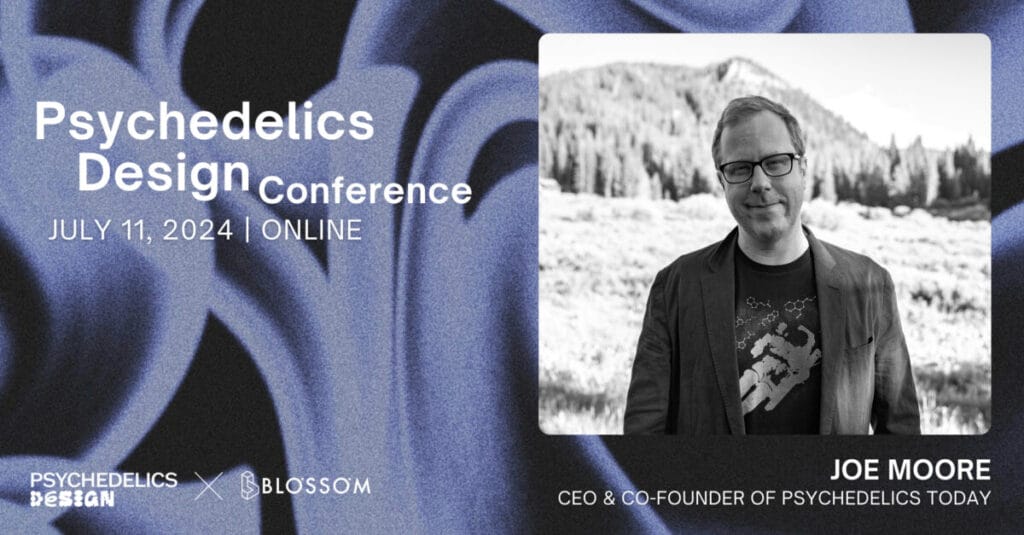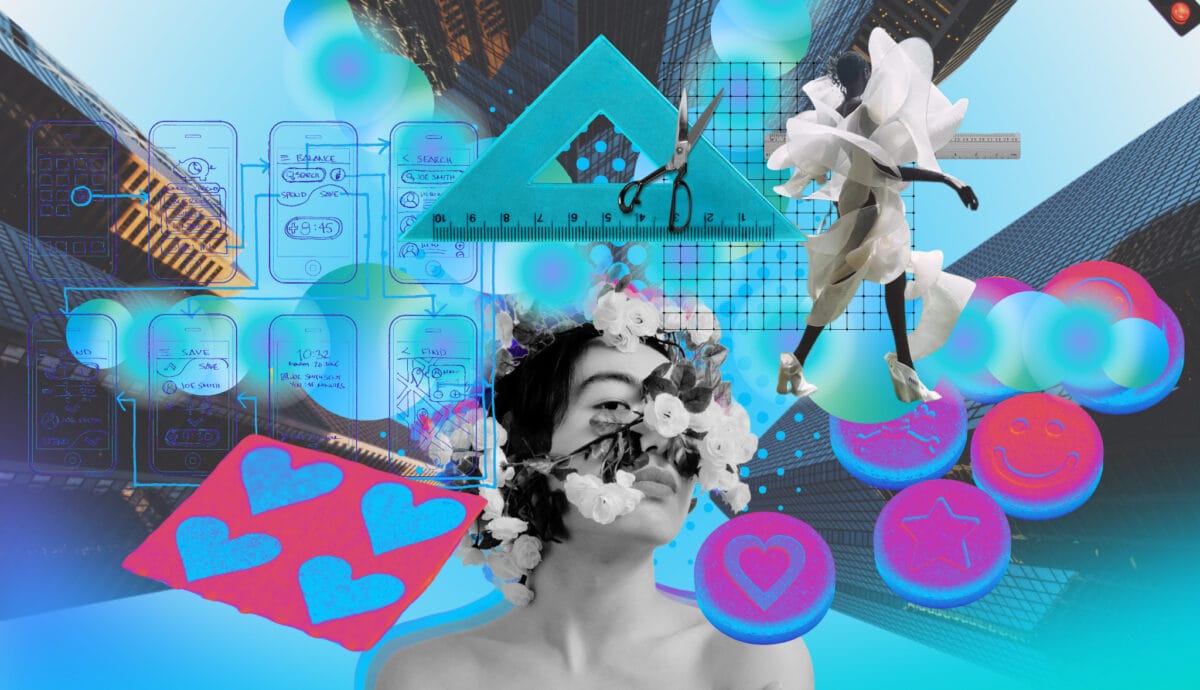It’s no secret that psychedelics and creativity are intrinsically linked. If you look around, you won’t have to go very far to find psychedelic-inspired byproducts from visionary figures whose work has changed the world, from Yoko Ono, to Aldous Huxley, to Steve Jobs.
While psychedelics’ impact on art is well-documented, the psychedelic influence on design remains largely unexplored, despite luminaries like Jobs attributing psychedelic experiences to shaping their design ethos.
How do people working in the design world work with psychedelics in 2024? Spoiler: psychedelics are being used to foster unconventional problem-solving, inspire new empathic design systems, and lead to designs that reconnect people with each other and the planet.

Psychedelics and the Creative Process
Psychedelic experiences influence creative processes in various ways. Research and anecdotal evidence suggest that psychedelics such as LSD and psilocybin can enhance creative thinking by inducing a hyper-associative state of cognition, increasing global entropy in the brain, and reducing conventional, logical thinking while giving rise to novel thoughts and insights. A 2022 Beckley Foundation study revealed that psychedelics can lead to a shift of cognitive resources towards originality, convergence, and symbolic thinking, which are fundamental phenomena for creativity. The altered state induced by psychedelics can unlock creativity by allowing individuals to imagine things that don’t exist, experience profound visual and sensory hallucinations, and increase connectivity in brain networks associated with idea generation and evaluation.
“My current creative process is intrinsically connected to psychedelics,” said Jannyl Molina, Psychedelics Today graphic designer. As part of her role, she reads unpublished articles (including this one), to distill and visually articulate the main themes and conceptual complexities such as ‘integration,’ the ‘default mode network,’ and the ‘War on Drugs.’
“In a way, my process for design is really informed by past psychedelic experience and current research,” Molina said. A 2019 Maastricht University study found that psilocybin has several notable effects on creative thinking. It led to a differentiation of effects over time and across constructs; it resulted in higher ratings of spontaneous creative insights; it decreased deliberate, task-based creativity; and seven days after psilocybin use, the number of novel ideas continued to be elevated.

Reconnecting Nature and Humanity Through Life-Centric Design
Beyond just design, there’s a bigger idea at play. Based on our work at Psychedelics Design, a platform exploring how psychedelics and design overlap, we think the benefits of psychedelics could deeply change how designers create.
By helping us understand what people need and making us appreciate nature more, psychedelics may inspire products and systems that are innovative, beautiful, profitable, and also good for the planet.
In design, it can’t be overstated the degree to which psychedelic experiences change an individual’s view of how humans and nature are connected. These profound experiences frequently evoke a profound sense of unity and interconnectedness among all life forms.
For designers, these new perspectives can become their inspiration to use more earth-friendly methods in their work. It may inspire switching to green materials and putting nature first in the assembly of their work. Psychedelic experiences also fill the design process with more caring and respect for nature, possibly guiding designers to solutions that keep ecosystems in balance.
“You likely can’t get too far into psychedelic exploration without feeling a deeper connection to nature. As we like to remind people in our work, everything is designed – by humans or by nature. And spoiler alert: humans are, in fact, just another expression of nature,” say Tracy DeLuca, founder of the How Might We Design LLC., and Elysa Fenenbock, founder of The School of Psychedelic Design. Both are instructors of Stanford’s Psychedelic Medicine x Design course.
“More specifically, psychedelic experiences have profoundly reshaped our view and reconnected us with nature’s own creative problem-solving abilities, honed over billions of years of evolution. Psychedelics have expanded our understanding of what’s possible in problem-solving and encouraged us to consider the needs of all living beings, not just humans,” the pair wrote.
A long-term follow-up study by MAPS founder Rick Doblin of the Good Friday experiment found that participants’ appreciation for life and nature was enhanced 24 years after their psilocybin experience, suggesting long-lasting impacts on nature-relatedness. The findings from these studies align with the biophilia hypothesis, which argues that humans naturally prefer nature because we evolved in it.
Molina says she found “greater urgency to care for nature and take care of others” when under the influence of psychedelics.
“It’s as if that inner wisdom says to me, ‘you are healing and need to aid others in their healing, so that Earth can also heal.’ That becomes louder each time I journey,” she said.
This natural connection may be why many people choose outdoorsy settings for psychedelic experiences and report a deep appreciation of the world around them. Together, this research suggests psychedelics could help fix our modern disconnect from nature by making us feel more connected to and appreciative of the environment.

Creative System Changes Through Psychedelic Design
The idea of changing how we design things after having mind-opening experiences with psychedelics is exciting. Instead of only thinking about what’s best for humans, we can think about what’s best for all living things. This could help us work together better and fix big problems in the world.
This shift from human-centered to life-centered design holds promise for addressing complex issues and presents an opportunity for designers to elevate their collaborative efforts with clients and stakeholders. Rather than isolating themselves within traditional structures, designers can integrate more deeply into organizations, becoming integral parts of the growth ecosystem.
“In the realm of healthcare, psychedelic medicine shows promise not only in providing relief for individual mental health challenges but also in catalyzing a broader transformation of our broken healthcare systems,” DeLuca adds.
By embracing principles of expanded consciousness, conscious connectedness, collaboration, regeneration, and reciprocity, the Psychedelics Design Philosophy offers the potential to revolutionize the very essence of how we approach design, moving beyond mere problem-solving to co-creating harmonious and sustainable solutions that resonate with the interconnectedness of all things.
While there is plenty of room and indeed a need for the design process to evolve and benefit from an expanded state of knowing and doing, Jeff Salazar, partner at McKinsey Design, sees potential to more dramatically shift design structures.
“After 30 years of consulting experience, I’ve seen many teams have less impact than they are truly capable of by isolating themselves as the keepers of the process and/or are hampered by living within a corporate structure that puts them a Grand Canyon away from where strategy gets shaped. To this point, I’m inspired to see us open the aperture on how we might reimagine ‘design’ becoming even more a part of (not apart from) the organizations and institutions that can gain greater benefit from the practice,” Salazar said.
The chance to create new ways of designing naturally with psychedelics is a hopeful idea for the future of creativity. It lets us go past the limits of how we design things now and imagine a new way forward. This way of designing is about being open, aware, working together, helping things grow back, and being good to each other. It could change not just how we make new things but also help make bigger changes in the world.
“It is from being in an expanded-state, that designers can gain new perspectives on their role – not only in creating highly desirable, harmonious and sustainable solutions – but also to help broaden and challenge how they engage within the overall ecosystem of growth,” Salazar said.
By using what we’ve learned from psychedelic experiences, we can start to take apart old ways of doing things that don’t work anymore. We can make a system that includes everyone and lasts a long time. Ultimately, this can lead to a world where all living things live together in a fair and peaceful way.

What Creatives Can Learn From Set & Setting
Making new things can seem impressive, but it’s a lot of hard work and can be tiring for both the body and the mind. Just like in psychedelics, having the right attitude and a good environment – a.k.a. ‘set and setting’ – is essential.
Similarly for creators, who often possess heightened sensitivity, factors like sound, scent, and others’ emotions can profoundly impact their work. Creative agencies and some tech giants have known for a long time that it’s important to give their workers a place where they can flourish. A great workplace for creatives might offer different rooms to work, a variety of refreshments, places to sit quietly, opportunities to practice yoga, and special headphones to block noise in busy work spaces.
Henry Winslow, founder of Tricycleday, says psychedelics have shifted in his perspective on the creative process.
“I don’t force ideas anymore; I create space for ideas now. It might sound like a semantic shift, but it’s not. In my days working at giant agencies, we’d schedule 30 or 60-minute structured brainstorming sessions. They didn’t reliably generate anything remarkable. Now, I understand that the answers are within me. It may sound corny, but I just have to create the conditions for them to reveal themselves spontaneously,” he said.
Many creatives also experience a sense of detachment or otherness, creative blocks, and feelings of impostor syndrome driven by the pursuit of perfection, all of which can significantly elevate stress levels.
“I have noticed that if I have a ‘creative block,’ microdosing or even doing a larger dose will help me return to my usual creative self. The process of ideation has to be generative, by definition, and psychedelics are primordial for linking up parts of my brain and allowing new ideas to burst out,” Molina says.
According to UCSF researcher Robin Carhart-Harris, whose pioneering fMRI study captured images of a healthy brain under the influence of a dose of LSD capable of inducing a trip, the psychedelic experience involves a breakdown of the conventional sense of self, replaced by a profound sense of connection with oneself, others, and the natural world. Commenting on the study, Carhart-Harris notes that “[i]n many ways, the brain in the LSD state resembles the state our brains were in when we were infants: free and unconstrained. This also makes sense when we consider the hyper-emotional and imaginative nature of an infant’s mind.”
Hector Pottie, creative director of Moving Brands, believes that “maybe psychedelics are something that would help create the right conditions for us to think wider, to think differently.”
Psychedelics have the potential to alleviate tension, silence our inner critics, foster receptivity, enhance our sense of connection, and ultimately unlock intricate visions. This could help us develop new ways to design things that are just right for the complexities of our world.
Amanda Feilding, Founder and Director of the Beckley Foundation, supports this view.
“The practice of mind-expanding activities such as the taking of psychoactive substances was, I think, fundamentally interwoven with the early development of man, helping to expand the boundaries of consciousness. The mind was opened to new visions by maximizing hyperconnectivity, and spreading further the network of simultaneous associations, inspiring higher levels of creativity and spirituality.”
A placebo-controlled study by Isabel Wießner and colleagues at the University of Campinas, Brazil, found that compared to placebo, LSD changed several creativity measurements pointing to three overall LSD-induced phenomena: a ‘pattern break’ reflected by increased novelty, surprise, originality, and semantic distances; decreased ‘organization,’ reflected by decreased utility, convergent thinking and, marginally, elaboration; and ‘meaning,’ reflected by increased symbolic thinking and ambiguity in the data-driven results.
Carly Dutch-Greene, founder of Studiodelic, says: “My psychedelic experiences have given me the ability to deeply attune to my intuition and because of that, I am able to transmute thoughts and ideas into visual designs in a really meaningful way.”
For designers, psychedelics open up a new realm of creative possibility, offering a unique tool for problem-solving and innovation. By altering perception and expanding consciousness, psychedelics may unlock creative insights that were previously inaccessible, paving the way for design solutions that contribute to regenerative futures.
It is essential to acknowledge the complexities and risks associated with psychedelics – they are not a panacea for creative problem-solving, and may not be the best choice for all creative thinkers. The ongoing dialogue within the design and psychedelic communities must carefully balance the potential creative insights with potential risks. While psychedelics may offer profound experiences and new avenues for exploration, we can’t overlook that they also carry legal, ethical, and health considerations, too.
Ultimately, the intersection of psychedelics and design carries both profound opportunities and formidable challenges. By proceeding with open yet critical minds, this intersection has the potential to expand the frontiers of humanity. With wisdom and care, this resurgence could catalyze a new creative wave that redesigns our innovations and how we innovate.



